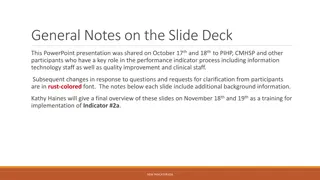Understanding Indicator 12: Transition from Early Intervention to Special Education
Indicator 12 measures the successful transition of children from Early Intervention to Special Education by evaluating the percentage of children referred from Early Intervention who are found eligible for special education services and have an Individualized Education Program (IEP) in place by their third birthday in Massachusetts. Compliance with Indicator 12 is crucial to ensure timely evaluations and provision of necessary services, preventing delays or denial of a free and appropriate public education.
Download Presentation

Please find below an Image/Link to download the presentation.
The content on the website is provided AS IS for your information and personal use only. It may not be sold, licensed, or shared on other websites without obtaining consent from the author. Download presentation by click this link. If you encounter any issues during the download, it is possible that the publisher has removed the file from their server.
E N D
Presentation Transcript
What is Indicator 12 (Transition from Early Intervention to Special Education)? Indicator 12 measures the percentage of children referred from Early Intervention who are found eligible for special education services and who have an Individualized Education Program (IEP) implemented on their 3rdbirthday. Indicator 12 includes: o Children who received Early Intervention services before their 3rdbirthday and who were referred by Early Intervention to the school district. o Children who are determined eligible and not eligible for special education services. It excludes: o Children referred by a parent or agency other than Early Intervention. 1 Massachusetts Department of Elementary and Secondary Education
Why is Indicator 12 important? Indicator 12 is one way that Massachusetts ensures that schools and districts comply with Individuals with Disabilities Act (IDEA) regulations (34 CFR 300.124 and 34 CFR 300.323) and Massachusetts special education regulations (603 CMR 28:04 - 28:06) for the transition of children from Early Intervention (birth to age 3) to special education (ages 3 to 22 years old). This Indicator ensures that children are evaluated in a timely way so that those determined eligible begin receiving needed services and supports at age three. If children do not receive evaluations and IEP services according to legally required timelines, this may result in delay or denial of a free and appropriate public education. 2 Massachusetts Department of Elementary and Secondary Education
How is Indicator 12 data collected? Indicator 12 data comes from information that school districts submit to the Department of Elementary and Secondary Education (DESE). The information includes: o Date school district received referral from Early Intervention. o Date parents consented to initial evaluation. o Date of team meeting. o Whether the student was eligible for services. o Reasons for delays. DESE reviews the submitted information to determine Indicator 12 compliance. 100% compliance is required. 3 Massachusetts Department of Elementary and Secondary Education
How is Indicator 12 calculated? Indicator 12 is measured using: Number of children served in Early Intervention and referred to special education. Number of children referred and determined not eligible. Number of children found eligible with an IEP in place by their 3rdbirthdays. Number of children for whom parent refusal to provide consent caused delays in evaluation or services OR to whom allowable exceptions applied under 34 CFR 300.301(d). Number of children determined eligible for Early Intervention services less than 90 days before their 3rdbirthdays. 4 Massachusetts Department of Elementary and Secondary Education
IEP Implementation Allowable Reasons for Delay Allowable Reasons for Delay 1. 2. The child was determined eligible for early intervention services under Part C fewer than 90 days before their third birthday. Despite repeated* requests from the LEA, the parent of the child: a. did not provide consent or revoked consent for evaluation. b. did not produce the child for evaluation. c. did not attend scheduled meetings. d. did not provide consent for initial services. Child is deceased. Child moved out of the jurisdiction of the LEA before their third birthday. Child s third birthday occurred over the summer; parents and LEA agree on the date IEP services will begin, and agreement is documented on the N1. * Repeated requests from the LEA is defined as two or more attempts by the LEA. All attempts (emails, phone calls, letters, etc.) must be documented and maintained by the LEA and are subject to review by the Department of Elementary and Secondary Education. 3. 4. 5. Reasons for Delay not Allowed All other reasons for development and implementation of an IEP past the child s third birthday result in a finding of noncompliance for Indicator 12, per the Individuals with Disabilities Education Act (IDEA). This includes children served in Part C but referred to Part B fewer than 90 days before the child s third birthday. The need for an Extended Evaluation under 603 CMR 28.05(2)(b) is not an allowable reason for delay. 5 Massachusetts Department of Elementary and Secondary Education
Resources Child Find Self-Assessment MA Online Training for Indicator 12 Technical Assistance Monitoring Transition from Part C Strategic Areas - Early Childhood Special Education Transition from Part C to Part B, Section 619 Services: Review of Existing Documentation for Children 6 Massachusetts Department of Elementary and Secondary Education























